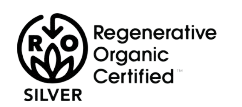Good Agricultural Practices & Regenerative Organic Certified Products By Pavitramenthe
Pavitramenthe deals with the Trading and processing of crop products and offers best quality to its maximum extent & Regenerative Organic Certified Products. To achieve that, we have certain policies and standards that is performed by our quality department at every step from production to dispatch the product to our customer. We maintain complete traceability in actual condition as well as in documents.
OUR PRACTICES
At our company, sustainability is at the core of everything we do. We hold the esteemed Fair for Life Certificate and Regenerative Organic Certificate (ROC), affirming our commitment to ethical practices, social responsibility, and environmental stewardship. We prioritize fair treatment of farmers, ensuring they receive equitable compensation for their efforts. Moreover, we actively work on reducing our carbon footprint throughout the production process, implementing eco-friendly practices and using renewable energy sources. With a strong foundation in sustainability, our products are not only good for consumers but also contribute positively to the planet
Our dedication to producing organic products is unwavering. We believe in the purity and goodness of organic farming, supporting small-scale farmers who practice regenerative agriculture. By adhering to stringent organic standards, we offer consumers safe, chemical-free products that promote well-being and health. Our organic commitment extends beyond the final product; we embrace the “Farm to Table” philosophy, prioritizing transparency and traceability, ensuring our customers know the origins of their food, and fostering a stronger connection between farmers and consumers.
Fairness lies at the heart of our company’s ethos. We firmly believe that a fair, ethical approach benefits everyone involved. We work closely with farmers, building strong relationships through mutual respect and understanding. By providing fair wages, empowering communities, and offering training and development opportunities, we create an environment where farmers thrive and feel valued. Our commitment to fairness goes beyond our immediate circle, supporting social initiatives and advocating for equitable practices throughout the industry.
Embracing the principles of regenerative agriculture, we strive to leave the Earth better than we found it. Our Regenerative Organic Certificate (ROC) is a testament to our dedication to soil health, biodiversity, and ecosystem preservation. Through regenerative practices, we focus on replenishing natural resources, enriching soil fertility, and promoting biodiversity. By working hand in hand with nature, we contribute to the restoration of ecosystems, fostering resilience and sustainability for generations to come.


Our Sustainable Agriculture Practices




Crop Rotation
Alternating crops each year can prevent soil erosion and depletion, as different crops use different nutrients and leave the soil in better condition.
Cover Cropping
Planting non-commercial crops such as legumes, grasses, or clover, in between cash crops, can enrich the soil with nutrients and organic matter.
Conservation Tillage
Leaving crop residue on the soil surface to reduce erosion and maintain soil structure. This technique can help reduce soil erosion, maintain soil moisture, and improve soil health.


Our Seamless Process
Efficiency in Every Step, From Concept to Completion.
Steam distillation is a widely used method in the extraction of essential oils from various plant materials. It is a gentle and efficient process that allows for the separation of volatile components from the plant matrix. Here’s a breakdown of the steam distillation process:Steam distillation is particularly suitable for heat-sensitive compounds and delicate plant materials. It is a preferred method for obtaining high-quality essential oils used in various industries, including perfumery, aromatherapy, and the production of natural flavors. The process is valued for its ability to preserve the delicate aromatic compounds present in plant materials.
Solvent extraction is a widely employed technique in the extraction of active ingredients from raw materials. Utilizing organic solvents as a medium, this method efficiently extracts the essential components required for various applications. The resulting miscella, containing the extracted substances, undergoes a de-solventization process, ensuring the production of oleoresins with minimal solvent residues. Solvent extraction and the subsequent production of oleoresins stand as a testament to the commitment to delivering superior flavor and aroma in a diverse range of culinary delights. This process provides a reliable and efficient means of harnessing the essence of raw materials, elevating the quality of food products across various industries.
Supercritical fluid extraction stands out as an efficient separation technique for extracting active ingredients from plant materials. This gentle and nature-friendly method utilizes food-grade CO2 as a supercritical solvent, ensuring the extraction of spices, herbs, and flowers at ambient temperature and high pressure. The key advantage lies in preventing the loss of aroma and degradation of active compounds.
Eco-Friendly and Residue-Free Process
Supercritical fluid extraction using CO2 is not only solvent residue-free but also highly regarded for its eco-friendliness. The process aligns with green practices, making it a sustainable choice for conscious manufacturing.
Crystallization is a fascinating and fundamental process in nature that encompasses the transformation of a substance from a disordered, chaotic state to a highly ordered, geometrically structured arrangement. This intricate phenomenon plays a pivotal role in various scientific, industrial, and everyday contexts, showcasing its versatility and significance. Crystallization is a captivating and ubiquitous phenomenon that transcends disciplines and industries. From the microscopic world of molecular interactions to the grandeur of geological formations, its influence is far-reaching and profound.
